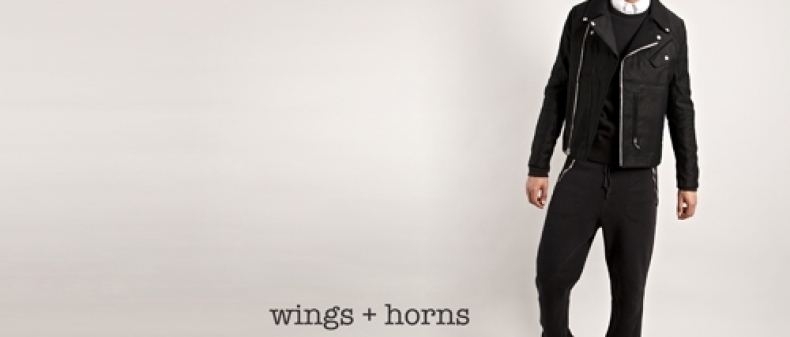
wings+horns is Canadian, albeit quietly Canadian. I say quietly because their clothing is not adorned with beavers, maple leafs, canoe paddles or other kitschy signifiers of our heritage. However, the Vancouver brand with ties to Toronto is very much a product of Canada (with some influences from Japan for good measure). Browsing recent collections, you’ll find flannels, thick-knit sweaters that could double as jackets, and hefty, padded vests. Their designs are effective and generally pretty straightforward. Which is why they’ve have become de rigeur among a certain demographic of young, urban men who are slowly (maybe even reluctantly) growing up. This is good for wings+horns, because there are a lot of us.
I talked to Craig Atkinson, CEO of wings+horns, about the Canadian landscape, working in Japan, and how to stay lean and local in a global marketplace.
First of all, tell me how Wings + Horns got started. I understand the brand has roots in Japan, Toronto and Vancouver…
wings+horns was really launched in Japan first and we worked our way back to North America. I was still partially living in Japan when we launched, in 2004, and it was a natural introduction into that market first. We were primarily focused on producing product for many other brands in Japan, Europe and North America. At that time we wanted to build something of our own.
In Japan, there exists a fanatical collectors’ market for vintage workwear and sportswear. How did this shape the brand?
I was actually dealing vintage in Japan. Going to swap meets and picking through all kinds of crap to find the odd gem that was left out there. It was a natural transition to start replicating the great pieces we found. We are still very much inspired by vintage work and military gear.
Was there a clear vision for this aesthetic from the very beginning?
Our philosophy is very simple. We strive to create high quality product that reflects the lifestyle we live and is in line with the believes and goals of our factory here in Vancouver.
What are your favourite garments? Think about the pieces in your wardrobe that you have owned for years (maybe decades) that you continue to come back to. How do those pieces inform your collections?
My go-to styles: 5-pocket selvedge jean (our first denim production in 2005, made in Japan), khaki westpoint twill chino, selvage bush pant, tiger fleece sweatshirt, melton wool mac jacket, Indie boots, Helmut bag. I think there is always a reminder that each garment should stand the test of time.
There are influences of the Canadian landscape in your pieces; the utilitarian detailing, rugged fabrics and simple, understated designs. Are there any landmarks or areas of Canada that particularly resonate with you?
As a kid I spent a lot of summers through the Rockies and now, living in Vancouver, we are in constant exposure to nature and the elements of being in the Pacific Northwest.
Large fashion retailers are starting to pay more attention to “streetwear” lately. Just one example is Club Monaco’s recent collaboration with A Continuous Lean. As a smaller brand, how do you see yourselves remaining competitive?
I think the DNA of who we are makes us competitive. We have our own manufacturing facility here in Vancouver, which I see as an advantage.
You have recently collaborated with Japanese bag manufacturer Porter and the Ace Hotel in New York. Who else would you like to work with in the future?
We really don’t have a grand scheme in the sense of collaborations. These things happen very naturally through friends in the industry.
As a business, how do you stay lean and scalable while maintaining high design and manufacturing standards?
We have a fortunate set-up here in Vancouver. While producing our own lines we are also producing products for other quality brands around the world. Being vertical from a manufacturing standpoint has really been an advantage, but doesn’t come without its challenges.
I can only name three stores in Toronto that carry your brand. Do you have a screening process for retailers? How does that relationship between designer and retailer work?
We consider the stores we sell to as our partners. Most of the buyers we deal with are the owners and have passion for their stores and an appreciation for what we do. I think mutual respect is a simple way of putting it.
Geoff Snack is the official problem-solver at Toronto Standard. Follow him on Twitter at @GeoffSnack.











